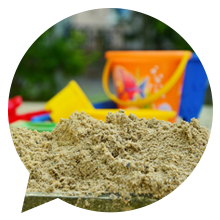Sand play in children's play areas

Introduction
Sand is one of the most popular - and developmentally appropriate - pieces of equipment which can be provided on a children's playground. It provides:
- opportunities for creative and construction play
- opportunities for fine-tuning physical movements
It has also received a bad press - primarily because of the requirements of maintenance and the effect on revenue costs. With the current trend to fencing play areas, there are more places where sand can be used and practical experience suggests that problems are much less than folk-lore suggests. These notes are primarily for sand play in unsupervised play situations.
Location
Orientation Shade in summer and maximum light in winter, although leaves from deciduous trees may be a problem
Seclusion Away from main traffic areas and quiet
Supervision From seating areas.
Size
As large as possible - but at least 15-20m2 for a park or village play-ground.
Shape
Wherever possible the sandpit should be an odd or irregular shape to offer a range of spaces within the area to allow for quiet secluded areas for individual play. Small platforms for putting things on (for example, sand castles) can be provided. A central platform of different coloured layers will help to indicate sand levels.
Orientation
Face the longest side of the sandpit in the most southerly direction.
Drainage
The sandpit must drain properly otherwise it becomes saturated and stagnates. Where there is good natural drainage on sandy or loamy soils or on slopes a pit can be constructed. Where there are clay soils or no slope, a sand box may be better.
Surrounding ground surface
If the playground is a busy one, a hard surface 2m wide with 50 max. inward slope surrounding the sand area is recommended to help clean up sand spillage and prevent contamination of the sand by bark or dirt.
Walls, base and edges
Walling materials can be logs, bricks, concrete. Sand depth should be at least 450mm and 75-150mm from the top. The top edge should be smooth and suitable for sitting on (by parents) or for building on. The base should be a gravel base (100-150mm) draining to a field drain, a 20-25mm of charcoal (if available) or geotextile material (i.e. Terram 1000 grade) and an open weave of bricks 10mm apart. A ramp should be provided down one side of the sand area to allow access by children with mobility difficulties and for wheeled toys. If timber sides are used they should be secured with coach bolts and screws - never nails. Whatever is used as a container must have chamfered or rounded edges.
Covers
If it is necessary to cover the sand an open cover made of, for example, an wire mesh is recommended to allow for natural cleansing and aeration.
Sand
Try to get white sand with a rounded particle profile and a grain size maximum of 1.25mm with a high proportion of fines. Sand suitable for impact absorption will not compact suitably for building sandpies. For a sand pit 3.5m x 2.7m x 450mm deep about 4.5cu.m of sand will be needed. NB. Builder's sand may stain.
Sand play structures
There are a number of sand play structures on the market and these can be sited in a suitably sized area (the supplier will advise). Look for items with plenty of activities, seating and shade. The problems of wear caused by the sand on timber rungs and steps and on painted metal can be serious.
Maintenance
Regular raking will be needed - ideally on a daily basis but never less than weekly. Periodic forking is necessary.
Depending on the frequency of use the sand will need a regular disinfectant treatment - a weak solution of child-safe household disinfectant should be sprinkled on using a watering can or similar and sprayed in with a hosepipe (or substantial downfall of rain!). Children should be kept out of the sand area for a day. Annual topping up and occasional replacement will be required.
Disability issues
The Disability Discrimination Act requires provision for disabled children. Whilst sand is not suitable for wheelchairs, sand play has considerable benefit for disabled children and the provision of suitable access ramps can turn a sand pit into a valuable resource under the requirements of the Act. The younger the child (or the younger their learning age) the more valuable sand is as a play medium.